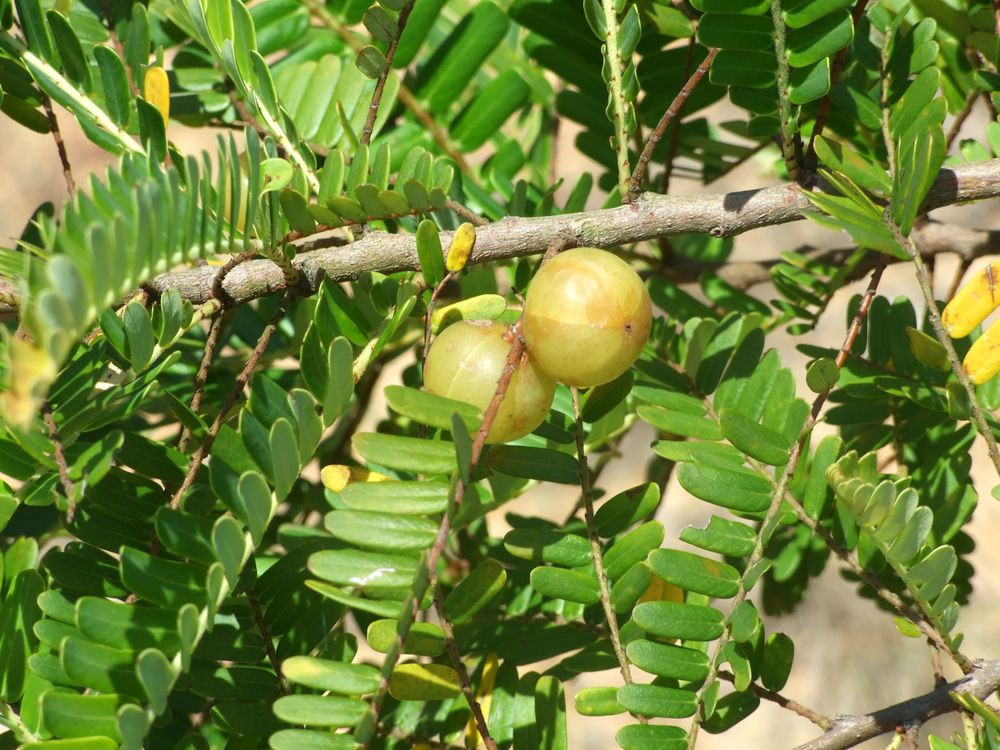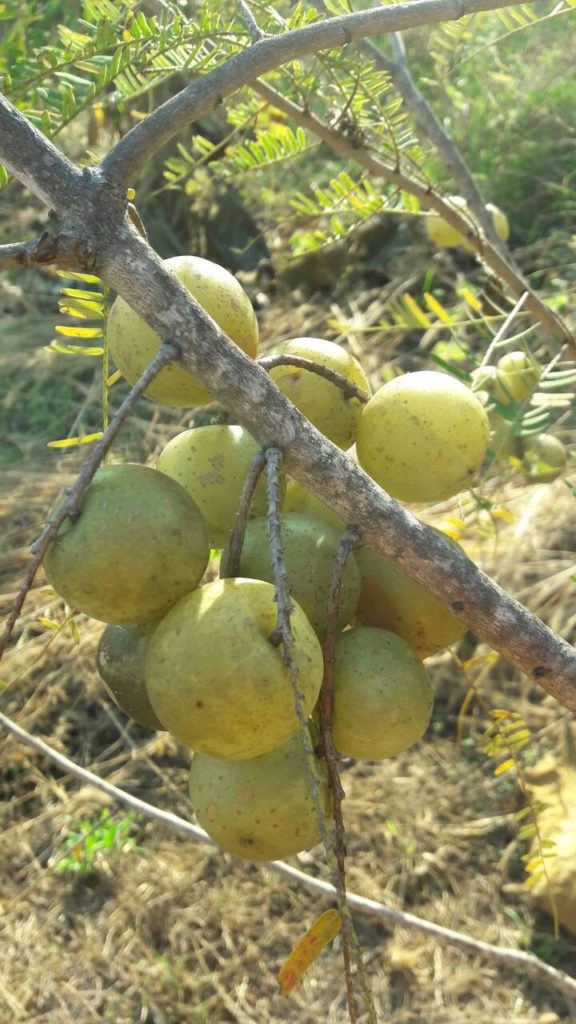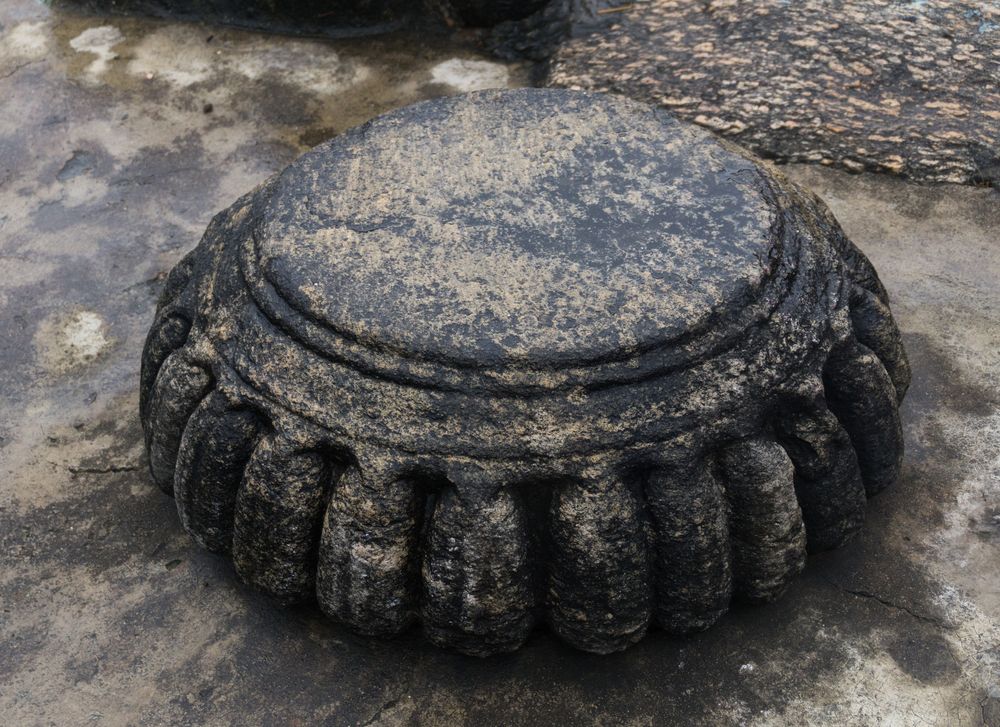This shrub, native to tropical Asia and probably India, is 4 to 6 m tall, highly branched and gnarled. Its small leaves are arranged in two rows at the end of the branches and take on the appearance of tamarind leaves, hence the Lao name “false tamarind”. The small flowers are located on the underside of the branches. The fruits resemble mak nyom (Phyllanthus acidus), but they are larger, cylindrical and just as acidic if not more so. They are rich in pectins, carbohydrates, minerals and vitamin C. and are regularly eaten. But they have another use, especially among the Akha, they are used to dye teeth black. The fruit is placed over the hearth for three days to ripen and then chewed with another leaf until the teeth turn black. The very hard wood of Phyllanthus emblica is used to make pestles and mortars, as is that of the Tamarind tree.
In traditional medicine, the fruit is considered a diuretic and is also used to combat diarrhoea and fever.
Cet arbuste, originaire d’Asie tropicale, et sans doute d’Inde, mesure 4 à 6 m; il est très ramifié et noueux. Ses petites feuilles sont disposées sur deux rangs à l’extrémité des rameaux et prennent l’aspect des feuilles de tamarin, d’où son nom lao de « faux tamarin ». Les fleurs petites sont situées à la face inférieure des rameaux. Les fruits ressemblent aux mak nyom (Phyllanthus acidus), mais ils sont plus gros, cylindriques et tout autant acides si ce n’est plus. Ils sont riches en pectines, glucides, minéraux et vitamine C. et sont régulièrement consommés. Néanmoins, ils ont une tout autre utilisation, en particulier chez les Akha, où ils servent à teindre les dents en noir. Le fruit est placé au-dessus du foyer pendant trois jours pour mûrir puis mâché avec une autre feuille jusqu’à ce que les dents noircissent. Le bois très dur de Phyllanthus emblica sert à faire les pilons et les mortiers comme d’ailleurs celui du Tamarinier.
En médecine traditionnelle le fruit est considéré comme diurétique, il permettrait également de lutter contre la diarrhée et la fièvre.





This shrub, native to tropical Asia and probably India, is 4 to 6 m tall, highly branched and gnarled. Its small leaves are arranged in two rows at the end of the branches and take on the appearance of tamarind leaves, hence the Lao name “false tamarind”. The small flowers are located on the underside of the branches. The fruits resemble mak nyom (Phyllanthus acidus), but they are larger, cylindrical and just as acidic if not more so. They are rich in pectins, carbohydrates, minerals and vitamin C. and are regularly eaten. But they have another use, especially among the Akha, they are used to dye teeth black. The fruit is placed over the hearth for three days to ripen and then chewed with another leaf until the teeth turn black. The very hard wood of Phyllanthus emblica is used to make pestles and mortars, as is that of the Tamarind tree.
In traditional medicine, the fruit is considered a diuretic and is also used to combat diarrhoea and fever.
Cet arbuste, originaire d’Asie tropicale, et sans doute d’Inde, mesure 4 à 6 m; il est très ramifié et noueux. Ses petites feuilles sont disposées sur deux rangs à l’extrémité des rameaux et prennent l’aspect des feuilles de tamarin, d’où son nom lao de « faux tamarin ». Les fleurs petites sont situées à la face inférieure des rameaux. Les fruits ressemblent aux mak nyom (Phyllanthus acidus), mais ils sont plus gros, cylindriques et tout autant acides si ce n’est plus. Ils sont riches en pectines, glucides, minéraux et vitamine C. et sont régulièrement consommés. Néanmoins, ils ont une tout autre utilisation, en particulier chez les Akha, où ils servent à teindre les dents en noir. Le fruit est placé au-dessus du foyer pendant trois jours pour mûrir puis mâché avec une autre feuille jusqu’à ce que les dents noircissent. Le bois très dur de Phyllanthus emblica sert à faire les pilons et les mortiers comme d’ailleurs celui du Tamarinier.
En médecine traditionnelle le fruit est considéré comme diurétique, il permettrait également de lutter contre la diarrhée et la fièvre.










This shrub, native to tropical Asia and probably India, is 4 to 6 m tall, highly branched and gnarled. Its small leaves are arranged in two rows at the end of the branches and take on the appearance of tamarind leaves, hence the Lao name “false tamarind”. The small flowers are located on the underside of the branches. The fruits resemble mak nyom (Phyllanthus acidus), but they are larger, cylindrical and just as acidic if not more so. They are rich in pectins, carbohydrates, minerals and vitamin C. and are regularly eaten. But they have another use, especially among the Akha, they are used to dye teeth black. The fruit is placed over the hearth for three days to ripen and then chewed with another leaf until the teeth turn black. The very hard wood of Phyllanthus emblica is used to make pestles and mortars, as is that of the Tamarind tree.
In traditional medicine, the fruit is considered a diuretic and is also used to combat diarrhoea and fever.
Cet arbuste, originaire d’Asie tropicale, et sans doute d’Inde, mesure 4 à 6 m; il est très ramifié et noueux. Ses petites feuilles sont disposées sur deux rangs à l’extrémité des rameaux et prennent l’aspect des feuilles de tamarin, d’où son nom lao de « faux tamarin ». Les fleurs petites sont situées à la face inférieure des rameaux. Les fruits ressemblent aux mak nyom (Phyllanthus acidus), mais ils sont plus gros, cylindriques et tout autant acides si ce n’est plus. Ils sont riches en pectines, glucides, minéraux et vitamine C. et sont régulièrement consommés. Néanmoins, ils ont une tout autre utilisation, en particulier chez les Akha, où ils servent à teindre les dents en noir. Le fruit est placé au-dessus du foyer pendant trois jours pour mûrir puis mâché avec une autre feuille jusqu’à ce que les dents noircissent. Le bois très dur de Phyllanthus emblica sert à faire les pilons et les mortiers comme d’ailleurs celui du Tamarinier.
En médecine traditionnelle le fruit est considéré comme diurétique, il permettrait également de lutter contre la diarrhée et la fièvre.


